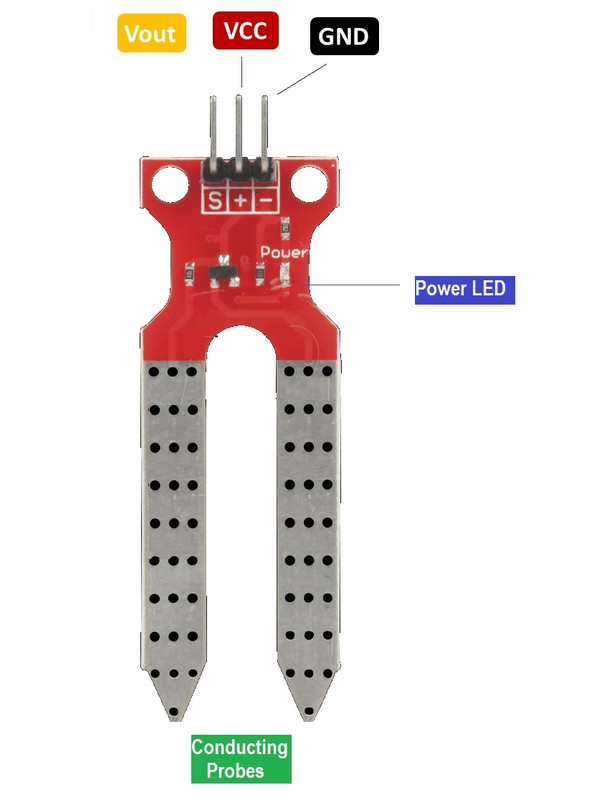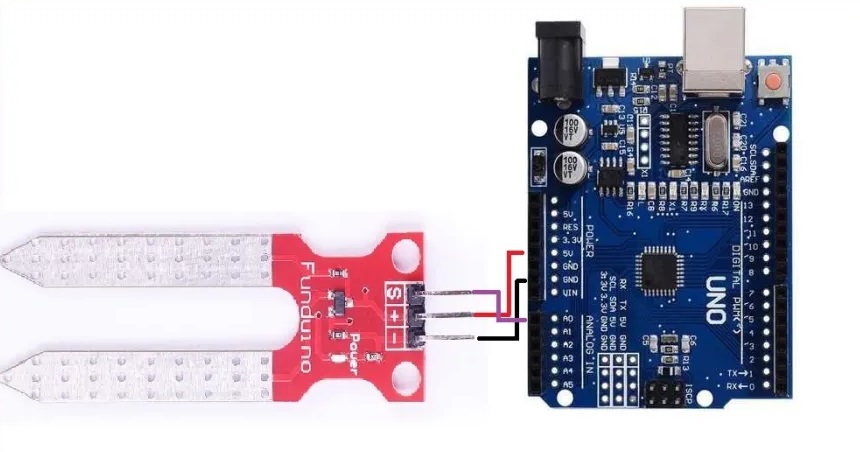AED 9.45
Description
The Soil Moisture Sensor Funduino is a device that measures the moisture content in the soil. It is a type of sensor that can be used to monitor the moisture levels in a plant's soil to help maintain optimal growing conditions.
Package Includes:
- 1 x Funduino Soil Moisture Sensor
Features:
- Easy to Use: The sensor is simple to set up and requires only a few connections to an Arduino board.
- High Sensitivity: The sensor is highly sensitive to changes in soil moisture content, making it ideal for monitoring small changes in soil moisture.
- Wide Operating Voltage Range: The sensor can operate at a wide range of voltages, from 3.3V to 5V, making it compatible with a variety of microcontrollers.
- Corrosion-Resistant Material: The sensor probes are made of corrosion-resistant material, which ensures long-term use in different soil conditions.
- Wide Detection Range: The sensor can detect soil moisture content in a range of 0 to 100% with an accuracy of ±5%.
- Low Power Consumption: The sensor consumes very little power, making it ideal for use in battery-powered systems.
- Analog Output: The sensor provides an analog output that can be easily read by an analog input of an Arduino board.
- Versatile: The sensor can be used in a variety of applications, including agriculture, environmental monitoring, and home automation.
- Cost-Effective: The Funduino Soil Moisture Sensor is a cost-effective solution for measuring soil moisture levels compared to other sensors in the market.
Description:
Soil Moisture Sensor Funduino is a type of sensor module designed to measure the moisture content of the soil. It is a small electronic device that can be embedded in the soil to provide real-time data on the soil's moisture level. The sensor module typically consists of two probes that are inserted into the soil and connected to a control board or microcontroller. The Funduino brand is a type of Arduino-compatible microcontroller board that can be used with the Soil Moisture Sensor module. Together, these components can be used to create a range of applications such as automated irrigation systems, moisture monitoring for plant growth, or soil moisture monitoring for agriculture and environmental research.
Principle of Work:
Soil Moisture Sensor works by measuring the electrical conductivity of the soil. The sensor module consists of two metallic probes, usually made of a conductive material, that are inserted into the soil. The probes are spaced apart at a fixed distance and are connected to a small control board. When the soil is moist, it contains ions and minerals that act as conductors of electricity. These conductive elements create a path of least resistance between the two probes, allowing current to flow through the soil and complete the circuit.
The control board measures the resistance between the two probes and converts it into a voltage output, which is proportional to the moisture level in the soil. The voltage output can be read by a microcontroller, such as an Arduino, or other devices to provide real-time data on the soil moisture level. When the soil is dry, the resistance between the probes increases, reducing the flow of current and resulting in higher voltage output. Conversely, when the soil is wet, the resistance decreases, increasing the flow of current and resulting in lower voltage output. By continuously measuring the voltage output of the Soil Moisture Sensor, users can determine the optimal watering schedule for plants, adjust irrigation systems to conserve water, and prevent over or under-watering.
Pinout of the Module:

The S (Analog Output) pin outputs an analog signal ranging from 5V to 0V.
GND stands for ground.
The sensor is powered by the VCC pin. It is recommended that the sensor be powered from 3.3V to 5V. Please keep in mind that the analog output will vary depending on the voltage supplied to the sensor.
Applications:
- Irrigation Systems: The sensor can be used to measure soil moisture levels to automatically control irrigation systems, ensuring that plants receive the optimal amount of water.
- Plant Growth Monitoring: The sensor can be used to monitor the soil moisture levels for plant growth in greenhouses, nurseries, or gardens.
- Environmental Monitoring: The sensor can be used to monitor soil moisture levels in forests, parks, and other natural areas to help manage the environment.
- Weather Stations: The sensor can be used to monitor soil moisture levels as part of a weather station to predict weather patterns and potential droughts.
- Home Automation: The sensor can be used as part of a home automation system to monitor soil moisture levels and control irrigation systems, lighting systems, and other devices.
- Research: The sensor can be used in scientific research to study the impact of soil moisture on plant growth, soil composition, and other environmental factors.
Circuit:
The module's Ground and VCC pins must be connected to the Arduino Board's Ground, and the S pins to pin A0 on the Arduino Board.

Library:
no library is needed.
Code:
This code is used to read the moisture level using a Soil Moisture Sensor connected to analog pin A0 of an Arduino board
int moisture = 0;
int percentage = 0;
void setup()
{ Serial.begin(9600); // serial monitor baud rate
pinMode(A0, INPUT); // PinMode set, pin for moisture sensor
}
void loop()
{
moisture = analogRead(A0); // reading value
percentage = map(moisture, 0, 1023, 0, 100); // changing to percent
Serial.print("Moisture= ");
Serial.print(percentage); // Print percentage
Serial.println("%");
delay(1000);
}
- First, the variables "moisture" and "percentage" are declared as integers and set to 0.
- In the setup() function, the serial communication is initiated with a baud rate of 9600, and pin A0 is configured as an input to read the sensor data.
- In the loop() function, the analogRead() function is used to read the value of the sensor connected to A0. The raw sensor value is stored in the "moisture" variable.
- The map() function is then used to convert the raw sensor value to a percentage value. The map() function takes five arguments: the value to be mapped, the minimum input value, the maximum input value, the minimum output value, and the maximum output value. In this case, the moisture value is mapped from a range of 0 to 1023 to a range of 0 to 100.
- The percentage value is then printed to the serial monitor using the Serial.print() function. The "%\n" at the end of the line is used to add a new line character to the end of the output.
- Finally, a delay of 1000 milliseconds (1 second) is added to the loop to avoid flooding the serial monitor with too much data.
This code can be used in a variety of applications where soil moisture needs to be monitored, such as automatic plant watering systems, agricultural irrigation systems, and environmental monitoring systems. The percentage value can be used to trigger alerts or actions based on the moisture level, such as turning on a water pump when the soil is too dry.
Technical Details:
- Color: Red + Silver
- Material: RF4
- Power Supply: 33V or 5V
- Working Current: Less than 20mA
- Output Voltage: 0~5 (5V when the sensor is completely soaked in the water)
- Supply Voltage: 5V
- Sensor Type: Analog output
- Service Life: 1 year approximately
- Weight: 70g
- Packaging Dimensions: 1200 x 780x 100mm
Resources:
Comparisons:
The main difference between the Soil Moisture Sensor Funduino and the Capacitive Soil Moisture Sensor V2 is the way they measure soil moisture. The Funduino sensor measures soil moisture indirectly by measuring the electrical conductivity of the soil, while the Capacitive Soil Moisture Sensor V2 measures soil moisture directly by measuring the dielectric constant of the soil.
The Capacitive Soil Moisture Sensor V2 consists of two electrodes that are inserted into the soil. One of the electrodes emits a high-frequency signal, while the other electrode measures the capacitance of the soil. The capacitance is affected by the amount of water in the soil, as water has a higher dielectric constant than soil particles. The capacitance reading is then converted into a moisture level reading using an onboard microcontroller.
In contrast, the Funduino Soil Moisture Sensor measures the electrical conductivity of the soil, which is affected by the amount of water in the soil. The two metallic probes of the sensor act as a variable resistor, where the resistance is inversely proportional to the soil moisture content. The resistance is then converted into a voltage reading, which is proportional to the moisture level of the soil.
Both sensors have their advantages and disadvantages. The Capacitive Soil Moisture Sensor V2 is more accurate and less affected by salinity and temperature changes, but it is more expensive and requires more calibration. The Funduino Soil Moisture Sensor is less expensive, easy to use, and works well in most soil types, but it is less accurate and can be affected by salinity and temperature changes. The choice between the two sensors depends on the specific application and the required level of accuracy.